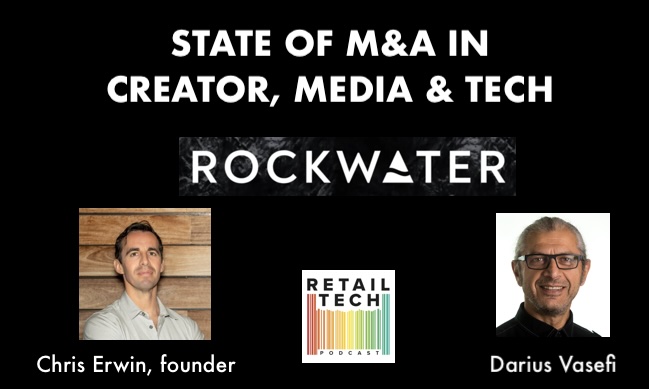

Interview with Chris Erwin on the state of M&A in Creator, Media and Technology in 2025.

Chris Erwin is the founder and principal of RockWater Industries, a strategic advisory firm specializing in the media, technology, and creator economy sectors. Established in 2019 and headquartered in Los Angeles, RockWater offers services such as M&A advisory, market research, growth strategy, and capital raising support to clients ranging from startups to Fortune 50 companies.
THE CREATOR ECONOMY
The creator economy refers to the ecosystem of independent content creators—such as YouTubers, podcasters, Twitch streamers, TikTok influencers, newsletter writers, and digital artists—who monetize their skills, audiences, and content through online platforms and tools. Unlike traditional media, creators operate as individual businesses, often acting as content producers, marketers, and entrepreneurs simultaneously.
This economy is powered by a range of monetization platforms (e.g., Patreon, Substack, OnlyFans), distribution tools(e.g., YouTube, Instagram, TikTok), and infrastructure enablers (e.g., Linktree, Koji, Kajabi, Stir). Increasingly, it also overlaps with commerce, education, and community offerings.
“The creator economy is the next generation of small business—personal, digital, and scalable.”
Key Figures:
Global Market Size (2023): ~$250 billion
Projected Market Size (2030): Over $500 billion
Number of Active Creators: Over 300 million people worldwide, with ~50 million considered semi-professional or professional
Top Platforms by Monetization Volume: YouTube, Instagram, TikTok, Patreon, OnlyFans, Substack
Key Segments:
Video-first creators (YouTube, TikTok, Twitch)
Writers/newsletters (Substack, Ghost, Beehiiv)
Educators/coaches (Teachable, Kajabi)
Influencer commerce (LTK, Shopify Collabs, PopShop Live)
Web3-native creators (NFTs, DAOs—emerging and volatile)
As creators become media companies in their own right, the sector has become ripe for mergers and acquisitions. The M&A landscape is fueled by a desire to own audiences, infrastructure, and IP.
Key M&A Trends
Platform Consolidation
Large platforms and tech firms are acquiring creator tools to build vertically integrated ecosystems.
Example: Canva acquired Flourish to enhance creator storytelling capabilities.
Commerce & Affiliate Infrastructure
Acquisitions target companies that enable creator-driven commerce, particularly in fashion, beauty, and lifestyle.
Example: LTK (LikeToKnowIt) acquired by rewardStyle and funded by SoftBank Vision Fund.
Talent Agency Rollups
Creator talent agencies and influencer marketing firms are being rolled up to create full-service digital media agencies.
Example: UTA and WME expanding their digital divisions with acquisitions.
Creator-Led IP & Brands
Buyers are investing in creator-founded consumer brands, often in health, wellness, and apparel.
Example: Emma Chamberlain’s Chamberlain Coffee received VC and strategic investor attention.
SaaS Tool Aggregation
Investors are bundling creator SaaS tools (editing, analytics, monetization) to offer all-in-one platforms.
Why M&A Matters in This Space
High Fragmentation: There are hundreds of tools, platforms, and services serving creators—many small, niche, and undercapitalized.
Audience Ownership: Acquirers want access to loyal audiences that creators have built.
Vertical Synergy: Integrating creation, monetization, community, and commerce increases LTV and defensibility.
Exit Pathways: Many solo founders or creator-facing SaaS startups seek acquisition as their most viable exit, due to limited IPO potential.
The Future Outlook
M&A in the creator economy is likely to accelerate as:
Media companies reposition toward direct-to-audience strategies
Retail and commerce firms seek to integrate influencer-driven discovery and conversion
AI tools personalize content creation at scale, fueling new products and acquisition targets
The Creator Economy is no longer niche—it’s mainstream, and M&A is shaping who controls its next chapter.